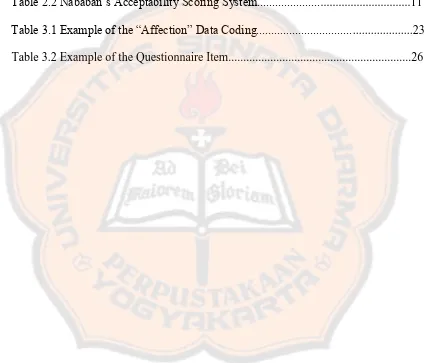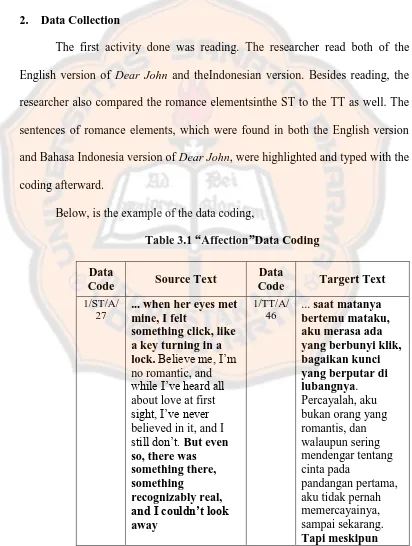I. Introduction
This thesis investigates the acceptability and translation strategies employed in rendering the romantic elements of Nicholas Sparks' Dear John into Indonesian. The study's rationale stems from the potential for cultural differences between English and Indonesian to lead to varied interpretations of romantic expressions. The research addresses two key questions: the acceptability of Barokah Ruziati's translation of these elements, and the specific translation strategies used. A field research methodology, involving questionnaires distributed to ten respondents, is employed to assess acceptability, supplemented by relevant literature and theories to ensure scientific rigor.
II. Review of Literature
This section examines related studies and pertinent theories. Related studies, such as Lengari's work on metaphor translation in Twilight, Sanusi's analysis of culturally loaded words in Harry Potter, and Nugroho's study of song translation, inform the current research's approach to translation strategy and acceptability. However, the current study distinguishes itself by focusing specifically on the romantic elements in Dear John and employing a different methodology. Key theories explored include various definitions of translation (Newmark, Catford, Nida and Taber), Nababan's framework for assessing translation acceptability (including its indicator and scoring system), and Suryawinata and Hariyanto's classification of translation strategies (structural and semantic). These theoretical frameworks provide the foundation for analyzing the data.
III. Methodology
The research employs a mixed-methods approach combining library research and field research. Library research involves a review of relevant literature and theoretical frameworks to support the analysis. Field research involves distributing acceptability questionnaires to ten Indonesian native speakers, aged 18-46, representing diverse backgrounds. The data comprises the English source text (Dear John) and its Indonesian translation, focusing on 55 romantic elements identified as sentences containing romantic expressions. Data analysis will incorporate Nababan's acceptability scoring system to quantify the acceptability of the translation and categorize the translation strategies employed according to Suryawinata and Hariyanto's framework.
IV. Analysis Results and Discussions
This section presents the findings of the analysis, separated into two main parts. The first part details the acceptability of the romantic elements translation, using Nababan's system to categorize each element as acceptable, quite acceptable, or unacceptable, based on respondent feedback. The analysis is structured around three categories of romantic elements: affection, endearment, and passion. The second part identifies and quantifies the translation strategies employed for each category, drawing on Suryawinata and Hariyanto's classification (transposition, synonym, subtraction, modulation, addition (structural and semantic), and omission). The discussion will connect the observed translation strategies to the overall acceptability scores, exploring the relationship between translation choices and the perceived success in conveying the romantic nuances of the original text.
4.1 The Acceptability of Romantic Elements Translation
This subsection presents the quantitative and qualitative results of the acceptability analysis of the romantic elements. The average acceptability score for the entire translation will be presented, along with a breakdown of scores for each of the three categories (affection, endearment, and passion). The discussion will analyze the factors contributing to variations in acceptability across different categories, considering potential cultural influences and the effectiveness of the translator's choices. Illustrative examples of high and low acceptability scores, along with respondent feedback, will provide deeper insights into the results.
4.2 The Translation Strategies Used
This subsection presents the frequency distribution of translation strategies identified in the translated text, broken down by category (affection, endearment, and passion). It will analyze the prevalence of each strategy, discussing the rationale behind the translator's choices in specific instances. The discussion will examine the relationship between the choice of strategy and the resultant acceptability scores, exploring whether particular strategies were more effective in conveying romantic nuances to the target audience. The analysis will discuss the implications of the dominant strategies and their suitability for translating romantic elements in this specific context.
V. Conclusion
This section summarizes the key findings, drawing overall conclusions about the acceptability of the Indonesian translation of the romantic elements in Dear John and the effectiveness of the translation strategies employed. The study's limitations will be acknowledged, and recommendations for future research will be offered. The overall conclusion will synthesize the findings from the acceptability and strategy analyses, providing a comprehensive assessment of the translation's success in conveying the romantic elements to Indonesian readers. The pedagogical implications of the study for translation training and the understanding of cross-cultural communication will also be discussed.
VI. Bibliography
A complete list of all sources cited in the thesis, adhering to a consistent citation style.
VII. Appendices
Supplementary materials such as the questionnaire, data tables, and potentially excerpts of the analyzed text are included in this section.




